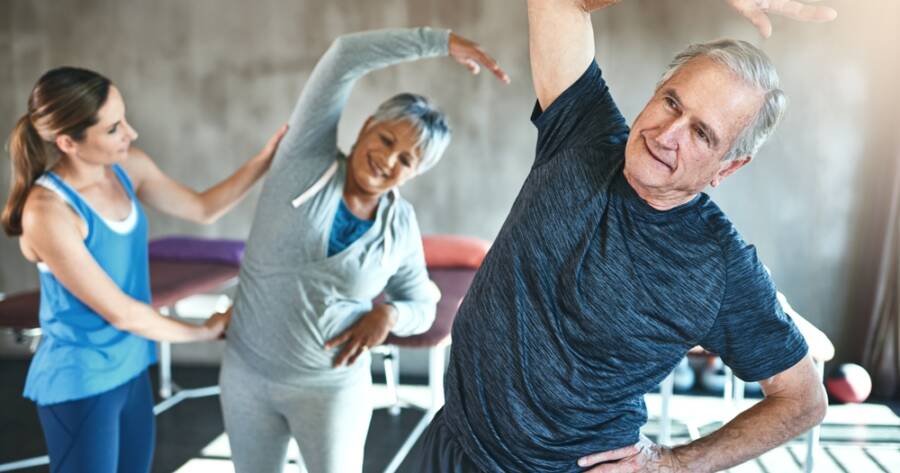Staying active is one of the most powerful things older adults can do to maintain their independence, boost their mood, and support overall health. While the physical changes that come with aging are natural, regular exercise can help reduce their impact—improving strength, balance, flexibility, and even cognitive function.
The good news? You don’t need a gym membership or intense workouts to feel the benefits. The best exercise routines for older adults are safe, low-impact, and focused on functional movement. Here’s how to get started—and stay moving.
Focus on Balance to Prevent Falls
Falls are a leading cause of injury in older adults, but balance-focused exercises can significantly lower the risk. By improving coordination and stability, seniors can move more confidently through everyday activities.
Try these gentle balance exercises:
-
Heel-to-toe walk: Walk in a straight line, placing one foot directly in front of the other. This strengthens leg muscles and enhances coordination.
-
Single-leg stand: Hold onto a chair or countertop and lift one foot slightly off the floor. Hold for 10–15 seconds, then switch legs.
-
Tai chi: This flowing, meditative movement practice is excellent for improving balance, posture, and body awareness.
Incorporating balance work into a daily or weekly routine can make a big difference in preventing trips and improving mobility.
Build Strength with Light Resistance Training
Muscle mass naturally declines with age, but resistance training helps maintain strength and function. This is especially important for tasks like lifting groceries, getting up from a chair, or climbing stairs.
Safe strength-building ideas for older adults:
-
Bodyweight exercises: Chair squats, wall push-ups, and step-ups can be done at home without equipment.
-
Resistance bands: These are gentle on joints and offer customizable tension for different fitness levels.
-
Light dumbbells: Simple movements like bicep curls, shoulder presses, or leg extensions help tone muscles and support joint health.
Aim for strength training 2–3 times a week, focusing on major muscle groups and allowing for rest days in between.
Maintain Flexibility Through Stretching
Tight muscles and stiff joints can lead to discomfort and limit movement. Regular stretching helps older adults stay flexible, reduce pain, and move with greater ease.
Simple stretches to include:
-
Neck and shoulder rolls to ease upper body tension.
-
Seated hamstring stretch: Sit on the edge of a chair, extend one leg straight, and reach gently toward your toes.
-
Gentle yoga: Modified yoga routines for seniors focus on flexibility, breathwork, and gentle movement.
Stretching daily or after physical activity keeps the body limber and reduces the risk of injury.
Support Heart Health with Low-Impact Cardio
Cardiovascular exercise strengthens the heart, improves circulation, and supports lung capacity—all vital for energy and endurance. For older adults, the key is to choose low-impact options that are easy on the joints.
Great cardio options include:
-
Walking: One of the easiest and most accessible ways to stay active. A daily 20–30 minute walk is a great goal.
-
Cycling (stationary or outdoor): Offers heart benefits without stressing knees or hips.
-
Water aerobics: The buoyancy of water makes this a joint-friendly, full-body workout.
Try to include moderate cardio activities at least 3–5 days per week, aiming for a pace that slightly elevates the heart rate while still allowing for conversation.
Exercise Tips to Keep It Safe and Sustainable
Before starting any new fitness routine, older adults should check with a healthcare provider—especially if they have existing health conditions or mobility challenges. Once cleared, here are some helpful guidelines:
-
Start slow and build up gradually. It’s okay to begin with just 5–10 minutes a day.
-
Warm up and cool down to prevent strain and injury.
-
Stay hydrated and listen to your body. Stop if you feel dizzy, short of breath, or experience pain.
-
Use support when needed, like a sturdy chair, wall, or railing for balance.
-
Make it enjoyable: Try walking with a friend, joining a class, or exercising with music to stay motivated.
The goal isn’t to “work out” like an athlete—it’s to move in ways that support your independence, health, and happiness.
Movement That Supports Everyday Life
The best exercise routine is the one you can stick with—one that fits your lifestyle, respects your body’s limits, and brings you a sense of accomplishment. Whether it’s a short daily walk, light strength training, or a yoga class at the local community center, staying active in later years is one of the most empowering choices older adults can make. With consistency and care, small steps lead to lasting benefits.

